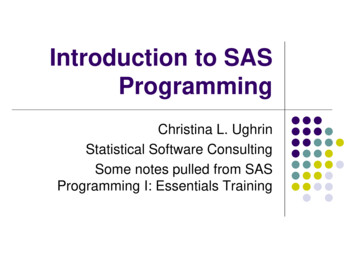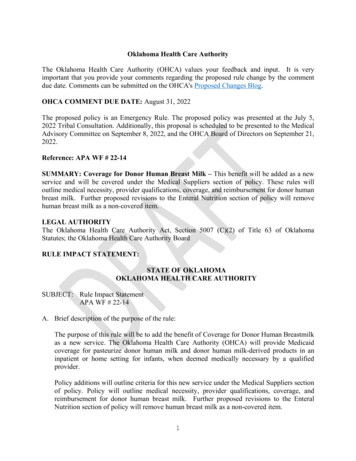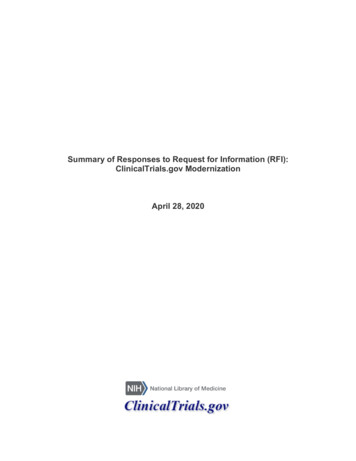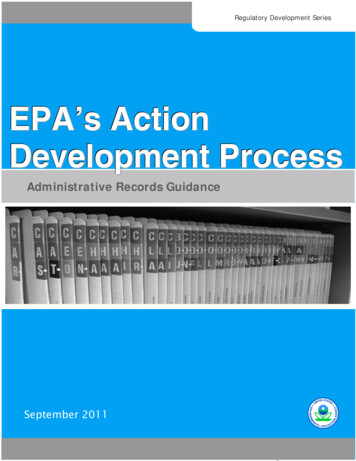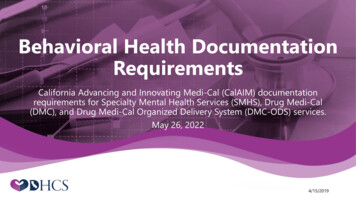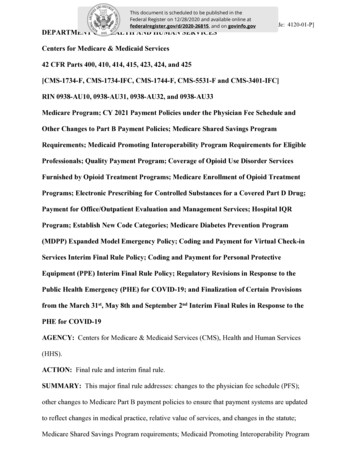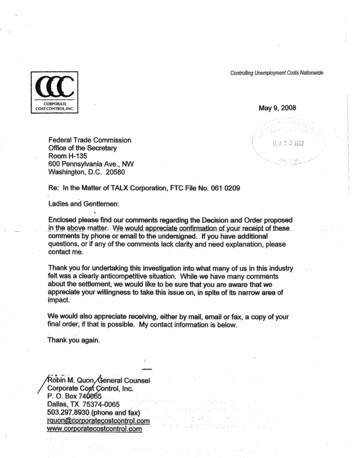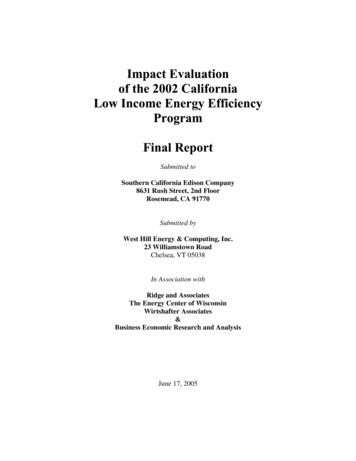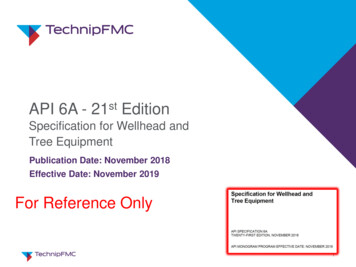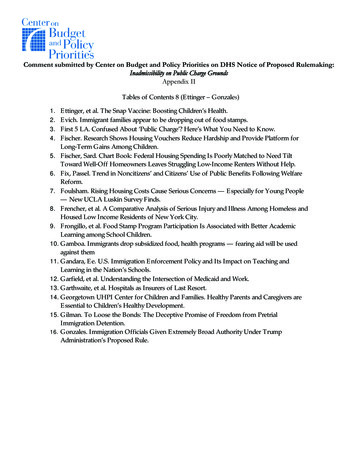
Transcription
Comment submitted by Center on Budget and Policy Priorities on DHS Notice of Proposed Rulemaking:Inadmissibility on Public Charge GroundsAppendix IITables of Contents 8 (Ettinger – Gonzales)1.2.3.4.Ettinger, et al. The Snap Vaccine: Boosting Children’s Health.Evich. Immigrant families appear to be dropping out of food stamps.First 5 LA. Confused About ‘Public Charge’? Here’s What You Need to Know.Fischer. Research Shows Housing Vouchers Reduce Hardship and Provide Platform forLong-Term Gains Among Children.5. Fischer, Sard. Chart Book: Federal Housing Spending Is Poorly Matched to Need TiltToward Well-Off Homeowners Leaves Struggling Low-Income Renters Without Help.6. Fix, Passel. Trend in Noncitizens’ and Citizens’ Use of Public Benefits Following WelfareReform.7. Foulsham. Rising Housing Costs Cause Serious Concerns — Especially for Young People— New UCLA Luskin Survey Finds.8. Frencher, et al. A Comparative Analysis of Serious Injury and Illness Among Homeless andHoused Low Income Residents of New York City.9. Frongillo, et al. Food Stamp Program Participation Is Associated with Better AcademicLearning among School Children.10. Gamboa. Immigrants drop subsidized food, health programs — fearing aid will be usedagainst them11. Gandara, Ee. U.S. Immigration Enforcement Policy and Its Impact on Teaching andLearning in the Nation’s Schools.12. Garfield, et al. Understanding the Intersection of Medicaid and Work.13. Garthwaite, et al. Hospitals as Insurers of Last Resort.14. Georgetown UHPI Center for Children and Families. Healthy Parents and Caregivers areEssential to Children’s Healthy Development.15. Gilman. To Loose the Bonds: The Deceptive Promise of Freedom from PretrialImmigration Detention.16. Gonzales. Immigration Officials Given Extremely Broad Authority Under TrumpAdministration’s Proposed Rule.
SNAPTheVaccineBoostingC hildren’sHealth“ The first goal of pediatrics is to protectchildren from suffering preventable illness.From that perspective SNAP is like aneffective immunization—it decreasesthe likelihood a young child will be sick,underweight, or developmentally atrisk. These conditions cause preventableFebruary 2012suffering for children and families, andincalculable avoidable costs to society nowChildren’s HealthWatchand in the future.”Deborah A. Frank, MDChildren’s HealthWatch This repor t was made possible by generousfunding from the Annie E. Casey Foundationand the Claneil Foundation.
Executive SummaryEvery day pediatric health providers use immunizations to protect children from diseases that make them sick, damage their brains, and mayeven threaten their lives. The right immunizations in the right doses at the right time save untold health and education dollars, not to mentionpersonal anguish and pain. Hunger and food insecurity in the U.S. also endanger the bodies and brains of millions of children.1 What is theright immunization to decrease a young child’s risk of ill health and slow learning? Adequate, healthy food. For 47 years American ingenuity hasmade that treatment efficiently available to millions of families through the Supplemental Nutrition Assistance Program (SNAP, formerly theFood Stamp Program), America’s strongest defense against hunger and food insecurity. About 50 percent of children in the United States areexpected to live in households receiving SNAP at some point in their childhood.2 Protecting the availability and enhancing the dosage of thiswidely used pediatric “vaccine” should be a major public health priority.Children’s HealthWatch demonstrated that SNAP, like an effective immunization, significantly decreases families’ and children’sfood insecurity, which are established child health hazards. Children’s HealthWatch also found that compared to young children infamilies that were likely eligible but not receiving SNAP, young children in families receiving SNAP were less likely to be underweightor at risk for developmental delays.When we specifically examined the impact of SNAP among young citizen children from immigrant families, those whose families receivedSNAP were more likely to be food secure and in better health than similar children whose immigrant families did not receive SNAP.Good health in the critical early years of life increases children’s chances of succeeding in school, preparing them—and by extension, the UnitedStates—to succeed in the competitive global job market of the future. Preserving SNAP’s flexible structure—that serves all who are eligible—and improving benefit levels so all participants are able to afford a healthful diet are key priorities for the Farm Bill and beyond. As Congressconsiders reauthorization of the Farm Bill, today’s leaders need to knowthe medical evidence showing SNAP is an effective vaccine for supportingthe healthy minds and bodies of our future leaders: our children.Food insecurity threatens children’s healthand well-being.Food insecurity occurs when families lack access tosufficient food for all family members to lead active,healthy lives. As compared to their food secure peers,young children in food-insecure households aremore likely to: be in fair or poor health be hospitalized be at risk for developmental delays have iron-deficiency anemiaChild food insecurity (the most severe level offood insecurity) occurs when children experiencereductions in the quality and/or quantity of mealsbecause caregivers can no longer buffer them frominadequate household food resources.Doctors know food insecurity and hunger aredangerous—jeopardizing children’s health andnormal development. Children are particularlyvulnerable to these dangers in the first three yearsof life: a critical period of development when brainand body must meet an urgent biologic timetablerequiring very high levels of quality nutrients. Earlychildhood food insecurity endangers children’sfuture academic achievement and adult healthand workforce participation. The Great Recession and jobless recovery increasedfood insecurityThe Great Recession had a detrimental impact on many families’ability to afford adequate healthy food, but food insecure familieswere hit hardest. A recent study by the Food Research andAction Center found that food spending among food insecurefamilies had declined considerably over the last decade.3 Parents’unemployment and the consequent descent into povertydisproportionately affected children, especially children under theage of 6. 4 Food insecurity is a frequent companion to poverty and,similarly, families with children under 6 have higher rates of foodinsecurity than those with older children only.
SNAP helps millions of Americans afford a nutritionally adequatediet each month.5 Participants can purchase food in authorized retailstores with an Electronic Benefit Transfer card. Eligibility and monthlybenefits are calculated based on family income and expenses. SNAPhas a high degree of program integrity due to its rigorous qualitycontrol systems6 —SNAP eligibility is confirmed by SNAP stateagencies through a wide range of data sources to check applicationinformation, including income and identity. In 2010, 43 percent ofrecipient households had incomes at or below half the poverty line,5equivalent to about 9,155 per year for a family of three.6 Nearly half(47 percent) of all SNAP participants are children5 and 76 percent offamilies receiving SNAP have at least one employed member.7Given the tight schedule of young children’s brain development,timely availability of adequate nutrition is essential. In the recentrecession, SNAP’s mandate to serve all eligible applicants workedas intended to rapidly reach those most affected by the downturn,7including families with children. As the economy improves andfamilies financially stabilize, SNAP’s counter-cyclical structure willcause participation to naturally constrict—by 2021, SNAP spendingis expected to fall to nearly pre-recession levels relative to the size ofthe economy.8SNAP has broadened access to healthful food by enabling recipientsto make purchases not only at retail food stores but also at farm toconsumer venues like farmers’ markets, and Community SupportedAgriculture (CSA). Every 5 in SNAP benefits generates as much as 9of economic activity within the U.S.,9 producing healthier children ineconomically stronger communities.10 SNAP—medicine for healthy bodies and mindsChildren’s HealthWatch analyzed data from more than 17,000young children whose parents sought care for them in a hospitalemergency department or primary care clinic between 2004 and2010. We compared children whose families received SNAP benefitsto those whose families did not receive them but were likely eligible(based on their participation in at least one other means-testedprogram). Families who reported that they did not want or did notneed SNAP were not included.We found that, in comparison to children whose families wereeligible but did not receive SNAP, young children whose familiesreceived SNAP benefits were significantly less likely to be at risk of: Underweight (an indication of undernutrition) Developmental delayseven after accounting for other possible factors, such asmaternal education and employment.We also found that children whose families received SNAP weresignificantly more likely to be living in food secure families andto be food secure themselves. SNAP helps families afford heating, health care, andother basic needsChildren’s HealthWatch found that families that received SNAPwere significantly less likely to have had to make trade-offsbetween paying for healthcare costs and paying for otherbasic needs, like food, housing, heating and electricity. Theconnection between families’ ability to afford to heat their homeand provide enough to eat is recognized through the benefitcoordination between SNAP and the Low Income Home EnergyAssistance Program (LIHEAP), called ‘Heat and Eat.’ The policymaximizes support for low-income populations, in turn translatinginto SNAP benefits that better cover the cost of food and thereforeprovide more meals for families.11Figure 1.SNAP helps children and families stayhealthy and afford other essential needsReduced Odds of Poor Outcomes SNAP provides crucial support to families1.2Source: Children’s HealthWatch. All reductionsstatistically significant at p 0.05Does Not Receive SNAPReceives SNAP10.80.60.40.20At Risk ofUnderweightAt Risk ofDevelopmentalDelaysChild FoodInsecurityHousehold Food Health CareInsecurityTrade-offs New AmericansChildren’s HealthWatch found that compared to children of U.S.born mothers, citizen children of immigrant mothers were morelikely to live in a two-parent family, have been born at a healthyweight and breastfed, and have a mother who is not depressed.12Despite this healthy start, young children of recent immigrants arealso more likely to be in poor health and food insecure.12 SNAP isan important medicine for children in these families, working tocounteract their heightened vulnerability. Compared to childrenof immigrant mothers who were likely eligible for SNAP but notreceiving it, children of immigrant mothers who were receivingSNAP were significantly more likely to be: in good or excellent health living in a food secure household child food secureTheir families were also less likely to have had to make healthcare trade-offs.
Ninety-three percent of children under six with immigrant parentsare American citizens,13 playing a critical role in our nation’s future.However, families headed by immigrants participate in SNAP and severalother public assistance programs at lower rates than their U.S.-borncounterparts.14 In part, these lower participation rates are due to a mixof regulatory barriers and misconceptions in the immigrant community.Legally qualified, able-bodied immigrant adults who have been in the U.S.for less than five years, even when eligible in all other ways, are ineligiblefor SNAP.15 This five year rule, combined with common misconceptionsabout the impact of receiving any government help on families’ abilityto obtain U.S. citizenship in the future, keeps families from accessingbenefits for themselves and for their eligible children, thus also missingout on the important health benefits of nutrition assistance.15Figure 2.SNAP helps children of immigrant mothersstay healthy and avoid food insecurity.Reduced Odds of Poor OutcomesSource: Children’s HealthWatch. All reductionsstatistically significant at p 0.051.2Does Not Receive SNAPReceives SNAP1 Increasing SNAP benefit levels improves family dietquality and children’s healthParticipation in SNAP plays a critical role in obesity prevention,both by improving dietary quality and by reducing foodinsecurity.20,9 In a nationally representative sample of female SNAPrecipients, higher SNAP benefits were associated with lower bodymass index.21 No studies have shown a causal link between SNAPparticipation and childhood obesity22 and research in recent yearssuggests no difference in obesity rates between SNAP participantsand non-participants.23In 2009, ARRA raised SNAP benefits across the board by aminimum of 13.6 percent.24 The added benefit for a four-personhousehold was 80/month.25 A USDA Economic Research Servicestudy showed that these ongoing ARRA SNAP enhancementsnot only created farm and non-farm jobs but also improvedhousehold food security among low-income families in a time oftremendous economic hardship.26Well-child: What every parent wants—a child who is notoverweight or underweight and whose parents report thats/he is in good health, developing normally for his/her age,and has never been hospitalized.0.80.60.40.20Fair/Poor ChildHealthChild FoodInsecurityHousehold FoodInsecurityHealth CareTrade-offs The cost of a healthy diet – out of reachSNAP is a good vaccine, but for many families the dose is too lowto purchase diets recommended by health care experts and theU.S. Department of Agriculture (USDA), even for those receiving themaximum benefit.16 The average SNAP participant receives 134 permonth ( 1.63 per meal) to supplement his/her food budget.17SNAP benefit amounts are based on the USDA’s Thrifty FoodPlan (TFP). The TFP was last updated in 2006 and no longerreflects the real cost of food in some areas. A 2008 Children’sHealthWatch study found that in Boston, the average monthlycost of the TFP was 39% higher than the maximum monthlySNAP benefit for a family of four; the average monthly cost inPhiladelphia was 49% above the maximum benefit.18 The benefitincrease implemented as part of the American Recovery andReinvestment Act (ARRA) helped close the gap, but the averagemonthly cost of the TFP in Philadelphia in 2011 was still 29%higher than the maximum monthly SNAP benefit.19Recent research from Children’s HealthWatch demonstrated thatimproved SNAP benefit levels also have a positive impact onchildren’s health. We compared the health of young children infamilies receiving SNAP with those in families that were likely eligiblefor the program but not receiving SNAP, before and after the ARRAbenefit increase. In the nearly two years after the increase,children in families receiving SNAP were significantly morelikely to be classified as “well” than were young children whosefamilies were eligible but did not receive SNAP.27As a result of legislation passed in 2010, these increased benefitlevels are scheduled to end in October 2013,16 several yearsearlier than anticipated, causing a sizable and abrupt benefitreduction for virtually all households in the program.28 When thereduction goes into effect, families of four will see a 51 monthlybenefit reduction, equivalent to a loss of about 31 meals permonth8 (based on the current average benefit per person permeal). Until benefit levels are adjusted to match the cost of ahealthy diet, in line with the latest scientific recommendations,SNAP’s great potential to relieve hunger, support children’shealth and healthy development, and promote a strongerAmerica cannot be fully realized.
Policy SolutionsProtecting children’s health with the SNAP vaccineSNAP is reauthorized every five years, under the Nutrition Title ofthe Farm Bill. In 2012, when the Farm Bill is due to come up forreauthorization, legislators have an opportunity to ensure that SNAPcontinues to improve its ability to support the health and learningpotential of America’s children. Our country’s future success dependson the strength and health of our children today. Therefore we must: Maintain the existing structure of SNAP, allowing the programto expand with rising need and shrink as natural disasters abateor the economy improves and families’ earnings increase. Replace the USDA’s Thrifty Food Plan with the Low-Cost FoodPlan—which more accurately reflects food pricing in strugglingcommunities—as the basis for the maximum SNAP benefit. Eachfamily’s benefit is based on both income and expenses; for thosefamilies with little or no gross income receiving the maximumallotment, the benefit falls short of actual food costs. Sustain the ARRA benefit level improvement, making it apermanent part of the SNAP benefit structure. The ARRA boost wasa good first step toward use of the Low-Cost Food Plan. Preserve food choice in the program, allowing families to takeresponsibility for choosing the most appropriate foods for theirhousehold. Healthy incentive programs, such as those offeringmatching benefits for fresh fruits and vegetables, support positivechoices and recognize the additional cost of fresh foods. Eliminate waiting periods for authorized immigrants, who wouldotherwise be eligible for benefits, to enhance the likelihood thattheir eligible children will also participate in SNAP. Increase outreach to immigrant families to ensure that all childrenreceive the nutritional supports for which they are eligible. Retain the “Heat and Eat” policy allowing states to continuestreamlining benefit coordination between SNAP and LIHEAPat all LIHEAP benefit levels.1Cook JT &Frank DA. Food Security, Poverty, and Human Development in the United States.Annals of the New York Academy of Sciences. 2008.16Food Research and Action Center. A Review of Strategies to Bolster SNAP’s Role in ImprovingNutrition as well as Food Security. July 2011.2Rank, M.R. & Hirschl, T.A. Estimating the risk of food stamp use and impoverishment duringchildhood. Archives of Pediatrics and Adolescent Medicine. 2009: 163 (11), 994-999.17Weill, J et al. A Tightening Squeeze: The Declining Expenditure on Food by American Households.Food Research and Action Center. December 2011.Thayer, J, et al. The Real Cost of a Healthy Diet: Coming Up Short; High food costs outstrip foodstamp benefits. C-SNAP at Boston Medical Center and The Philadelphia Grow Clinic. September2008.3DeNavas-Walt, C, et al. Income, Poverty, and Health Insurance Coverage in the United States.US Census Bureau. Current Population Reports. 2011 Annual Social and Economic Supplement.September 2011.4Eslami, E, et al. Characteristics of Supplemental Nutrition Assistance Program Households: FiscalYear 2010. U.S. Department of Agriculture, Food and Nutrition Service, Office of Research andAnalysis, 2011.5Center on Budget and Policy Priorities. Introduction to the Supplemental Nutrition AssistanceProgram (SNAP). Policy Basics Series. January 2012.6Bean, J. Reliance on Supplemental Nutrition Assistance Program Continued to Rise Post-Recession.Carsey Institute. Issue Brief NO.39. Fall 20117Rosenbaum, D. House Passed Proposal to Block-Grant and Cut SNAP (Food Stamps) Rest on FalseClaims About Program Growth. Center on Budget and Policy Priorities. June 2011.8USDA/FNS. SNAP Average Monthly Benefits Per Person. 2011.1819Breen, A, et al. The Real Cost of a Healthy Diet: 2011. Center for Hunger Free Communities andChildren’s HealthWatch. November 2011.20Mabi, J. et al. Food expenditures and Dietary Quality Among Low-Income Households andIndividuals. Report to the U.S. Department of Agriculture, Food and Nutrition Service. WashingtonDC: Mathematic Policy Research, Inc. 201021Jilcott et al. Associations between Food Insecurity, Supplemental Nutrition Assistance Program(SNAP) Benefits and Body Mass Index among Adult Females. Journal of the American DieteticAssociation. 201122Neault, N. et al. The Safety Net in Action: Protecting the Health and Nutrition of Young AmericanChildren—Report from a Multi-Site Children’s Health Study. Children Sentinel Nutrition AssessmentProgram. July 2001; Hofferth, S.L. and Curtin, S. Poverty, Food Programs, and Childhood Obesity.Journal of Policy Analysis and Management. 2005; 24(4):703-26923Paggi, MS. Food and Nutrition Programs in the Next Farm Bill. Choices Magazine. 2nd Quarter26(2). 201110Perry, A, et al. Food Stamps as Medicine: A New Perspective on Children’s Health. Children’sHealthWatch,2007.24The actual percentage increase for each household varied and often turned out to be higher than13.6 percent due to the calculation laid out in the ARRA legislation. The USDA used the maximumbenefit as a base and calculated a 13.6 percent benefit increase for each household size. They thenkept the dollar amount of this increase constant and applied that amount to all benefit levels of thesame household size.Hanson, K. The Food Assistance National Input-Output Multiplier (FANIOM) Model and theStimulus Effects of SNAP. ERS Summary Report. Economic Research Service. US Department ofAgriculture. October 201011Baker, P, et al. Heat and Eat. Using Federal Nutrition Programs to Soften Low-Income Households’Food/Fuel Dilemma. Food Research and Action Center. March 2009.Chilton, M, et al. Food Insecurity of and risk of poor health among US-born children of AmericanImmigrants. American Journal of Public Health. Vol.99(3). 200912Capps, R, et al. The Health and Wellbeing of the Young Children of Immigrants. Urban Institute,November 2004.13Bitler, M, & Hoynes, H. Immigrants, Welfare Reform and the U.S. Safety Net. Prepared for theProject: “Immigration, Poverty, and Socioeconomic Inequality”. June 2011.14Guillen, I. Institute Notes: Hunger and Poverty Among Latino Immigrants. Bread for the WorldInstitute. June 2011.1525Richardson, J. et al. Reducing SNAP (Food Stamp) Benefits Provided by the ARRA: P.L. 111-226 & S.3307. Congressional Research Service. August 2010.26Food Security Improved Following the 2009 ARRA Increase in SNAP Benefits. U.S. Department ofAgriculture, Economic Research Service. Economic Research Report Number 116, April 2011.27March, E, et al. Boost to SNAP Benefits Protected Young Children’s Health. Children’s HealthWatchOctober 2011.28Rosenbaum, D. SNAP is effective and efficient. Center on Budget and Policy Priorities. January,2012.
C H I L D R E N ’SHealthWatch“ With the money food stamps provides, I was able to feed my daughter breakfast inthe morning. Without it, what would she have eaten? She had cereal. She had milk.She didn’t have to go without.”Crystal S.Witness to HungerAbout Children’s HealthWatchAuthorsChildren’s HealthWatch is a nonpartisanpediatric research center that monitorsthe impact of economic conditions andpublic policies on the health and wellbeing of very young children. For morethan a decade, Children’s HealthWatchhas interviewed families with youngchildren in five hospitals—in Baltimore,Boston, Little Rock, Minneapolis, andPhiladelphia—that serve some ofthe nation’s poorest families. Thedatabase of over 42,000 children, morethan 80 percent of whom are fromracial and ethnic minority groups, isthe largest clinical database in thenation on very young children livingin poverty. We collect and analyze awide variety of information, includingdata on household demographics, foodsecurity, public benefits, housing, homeenergy and children’s health status anddevelopmental risk.Stephanie Ettinger de Cuba, MPH, Researchand Policy Director; Ingrid Weiss, MS, PolicyAnalyst; Justin Pasquariello, MBA, MPA,Executive Director; Ashley Schiffmiller,Program Coordinator; Deborah A. Frank,MD, Founder and Principal Investigator;Sharon Coleman, MS, MPH, StatisticalAnalyst; Amanda Breen, PhD, ResearchCoordinator; and John Cook, PhD, MAEd,Co-Principal Investigator.AcknowledgementsChildren’s HealthWatch would also like tothank Ellen Vollinger of the Food Researchand Action Center, Pat Baker of theMassachusetts Law Reform Institute andRachel Meeks Cahill, Children’s HealthWatch– Philadelphia for their thoughtful andcareful review of this work.Design by Yellow Inc.Photo: Christina K.
EXCLUSIVEEmails of top NRCC officials stolen in major 2018 hackTo give you the best possible experience, this site uses cookies. If you continuebrowsing, you accept our use of cookies. You can review our privacy policy to find outmore about the cookies we use.Accept
Immigrant households legally eligible for food-stamp benefits stopped participating in the program at a higher-thannormal rate in the first half of this year. Spencer Platt/Getty ImagesAGRICULTUREImmigrant families appear to be dropping out of food stampsBy HELENA BOTTEMILLER EVICH 11/14/2018 10:55 AM ESTPresident Donald Trump’s hard-line immigration rhetoric and policies may be driving lowincome immigrant families away from food stamps.Immigrant households legally eligible for food-stamp benefits stopped participating in theprogram at a higher-than-normal rate in the first half of this year, a preliminary study releasedthis week indicates.The data is the first broad look at Supplemental Nutrition Assistance Program participationdeclines among immigrants, surveying more than 35,000 mothers across five U.S. cities. It foundthat participation in the SNAP dropped by nearly 10 percentage points in the first half of 2018 forimmigrant households that are eligible for the program and have been in the United States lessthan five years.To give you the best possible experience, this site uses cookies. If you continuebrowsing, you accept our use of cookies. You can review our privacy policy to find outAccept Texas,The study seems to confirm months of anecdotal reports, from New York to San Antonio,more about the cookies we use.that widespread fear in immigrant communities has had a chilling effect on participation in
SNAP and other government aid programs like WIC, a federal nutrition program aimed atpregnant women and children.“We were hearing the anecdotal reports of people dropping out of SNAP and WIC, so we startedlooking at our data to see if that was true among the families we interview,” said Allison BovellAmmon, lead researcher and deputy director for policy strategy at Boston Medical Center’sChildren’s HealthWatch, which conducted the study.Morning Shift newsletterGet the latest on employment and immigration, every weekday morning — in your inbox. Your email By signing up you agree to receive email newsletters or alerts from POLITICO. You can unsubscribe at any time.Children’s HealthWatch is a network of pediatricians and health researchers that tracks datafrom urban hospitals across the country, with the goal of measuring how various policies areimpacting children in real time.The notion that low-income families who are legally eligible for government assistance but areafraid to access such services is alarming for anti-hunger and health advocates.Undocumented immigrants are not eligible to receive SNAP benefits, but households can receiveassistance for their U.S. citizen children if they meet the income requirements.The latest SNAP study surveyed mothers of children four years and younger in five cities: Boston,Baltimore, Philadelphia, Minneapolis and Little Rock, Ark. Researchers interviewed immigrantfamilies in primary clinics and emergency rooms, asking questions about their family’s level offood security as well as participation in SNAP, among other topics.The report found that SNAP participation had been increasing between 2007 and 2017 forimmigrant families whose mothers had been in the United States for less than five years. The rateof participation had gone up to 43 percent over those 10 years. But in the first half of 2018 thetrend started to reverse, the survey showed, dropping nearly 10 percentage points to 34.8 percentfor the same subset of families.Immigrant families with mothers who have been in the U.S. more than five years did not show asteep decline. Among these families, SNAP participation declined from 44.7 percent to 42.7percent,a 2 percentage point drop.To give you the best possible experience, this site uses cookies. If you continuebrowsing, you accept our use of cookies. You can review our privacy policy to find outAccept The SNAP study, which is preliminary and has not yet been published in a peer-reviewed journal,more about the cookies we use.was released this week at the American Public Health Association’s annual meeting in San Diego.
Researchers cautioned that there could be many explanations for the trend, though they surmisethe current political environment is a major contributing factor. In a statement announcing theresults, Bovell-Ammon cited immigration rhetoric, increased immigration enforcement anddetention, and other policy changes, as potential drivers.“We think that’s a likely reason for many people dropping out, but it could also be because theeconomy is improving as well,” Bovell-Ammon told POLITICO in an interview. “I am a littlecautious to not over extrapolate the results to a single cause.”WHITE HOUSEStaff anger spills over at White HouseBy CHRISTOPHER CADELAGO and NANCY COOKSNAP enrollment has been dropping as the economy has improved, but the numbers have notreturned to pre-recession levels. At its peak in 2013, the program covered 47 million people. Thenumbers have dropped closer to 41 million, according to the most recent figures from USDA.The USDA’s Food and Nutrition Service, which administers SNAP at the national level, said itwon’t comment on unpublished data, but a spokesperson said the agency appreciated studies“about these valuable programs.”“FNS wants to ensure that all individuals eligible for
households and just 40 percent of those with severe housing cost burdens. 6 Part III: Housing Needs Among Renters Are Growing This imbalance has grown in recent years as the number and share of renters who have difficulty affording housing have risen. Since 2006, the number of renter households has grown by nearly 9 million,
